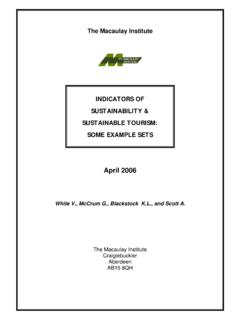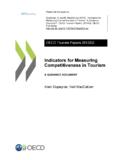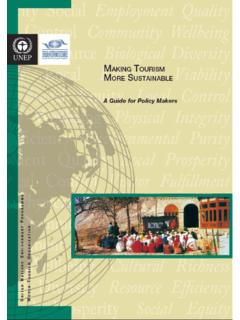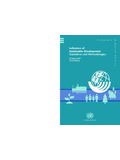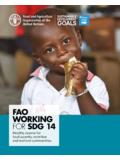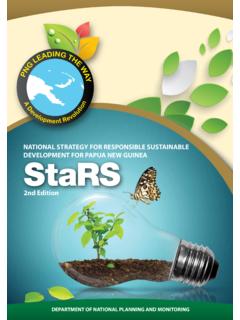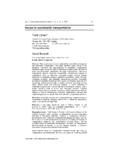Transcription of Indicators of Sustainable Development for …
1 Indicators of Sustainable Developmentfor tourism DestinationsA GuidebookCopyright 2004 World tourism Organization Calle Capit n Haya, 4228020 Madrid, SpainIndicators of Sustainable Development for tourism Destinations: A GuidebookISBN 92-844-0726-5 Published and printed by the World tourism Organization, Madrid, SpainFirst printing in 2004 All rights reservedThe designations employed and the presentation of material in this publication does not imply theexpression of any opinions whatsoever on the part of the Secretariat of the World tourism Organizationconcerning the legal status of any country, territory, city or area, or of its authorities or concerning thedelimitation of its frontiers or tourism OrganizationCalle Capit n Haya, 4228020 Madrid, SpainTel.: (+34) 915 678 100 Fax: (+34) 915 713 733 Web site: Email: This publication may be reproduced for such purposes as criticism, comment, news reporting, teaching,scholarships, or research, or for use by member country governments, in which the use is for non-commercial purposes is freely authorized, with due credit to the WTO source.
2 The WTO wouldappreciate receiving a copy of any publication that uses this publication in these circumstances as a use of this publication may be made for resale or any other commercial purpose whatsoever withoutprior permission in writing from the WTO. For applications see 2004 World tourism Organization - ISBN 92-844-0726-5 Acknowledgements .. 1 Preface .. 3 How to Use this Guidebook .. 5 Part 1 Introduction .. Indicators of Sustainable Development for tourism .. Why Use Indicators ? .. Indicators at Different Levels .. Types of Indicators .. Measurement and Expression of Indicators .. Indicators and Planning .. Indicators as a Catalyst .. Progress in Indicators Development and Use .. Growing Indicators Initiatives Worldwide .. Advances in Indicators Methodologies.. Indicators Initiatives of Other Sectors .. Indicators and Performance Measurement.. Expected Use and Users.
3 19 Part 2 indicator Development Procedures .. Key Steps to Indicators Development and Use .. 22 Initial Phase: Research and Organization .. 24 Step 1 Definition/Delineation of the Destination .. 24 Step 2 Use of Participatory Processes.. 26 Step 3 Identification of tourism Assets and Risks; Situation Analysis.. 32 Step 4 Long-term Vision for a Destination .. 35 indicator Development Phase .. 35 Step 5 Selection of Priority Issues and Policy Questions .. 35 Step 6 Identification of Desired Indicators .. 37 Step 7 Inventory of Data Sources .. 38 Step 8 Selection Procedures .. 40 Implementation .. 43 Step 9 Evaluation of Feasibility/Implementation Procedures.. 43 Step 10 Data Collection and Analysis .. 46 Step 11 Accountability and Communication .. 50 Step 12 Monitoring and Evaluation of Indicators Application .. Use of Other Sections of the Guidebook within this Process .. 54 Table of ContentsPart 3 Sustainablility Issues and Indicators in tourism .
4 55 The Presentation of the Issues and Their Indicators .. Wellbeing of Host Communities .. Local Satisfaction With tourism Baseline Issue.. 56 Attitudes, Dissatisfaction, Community Effects of tourism on Communities Baseline Issue.. 57 Community Attitudes, Social Benefits, Changes in Lifestyles, Housing, Access by Local Residents to Key Assets .. 65 Access to Important Sites, Economic Barriers, Satisfaction with Access Gender Equity .. 68 Family Wellbeing, Equal Opportunities in Employment, Traditional Gender Roles, Access to Land and Sex tourism .. 71 Child Sex tourism , Education, Prevention Strategies, Control Sustaining Cultural Assets.. Conserving Built Heritage .. 76 Cultural Sites, Monuments, Damage, Maintenance, Designation, Community Participation in tourism .. Community Involvement and Awareness .. 83 Information, Empowerment, Participation, Community Tourist Satisfaction.
5 Sustaining Tourist Satisfaction Baseline Issue.. 86 Expectations, Complaints, Problems, Accessibility .. 90 Mobility, Older Tourists, Persons with Disabilities Health and Safety .. Health .. 94 Public Health, Community Health, Food Safety, Worker Health and Safety Coping with Epidemics and International Transmission of Disease .. 101 Facilitation, Contingency Planning, Impacts on Tourist Security .. 104 Risk, Safety, Civil Strife, Terrorism, Natural Disasters, Impacts, Management Response, Contingency Planning, Local Public Safety .. 109 Crime, Risk, Harassment, Public Security, Tourist Capturing Economic Benefits from tourism .. tourism Seasonality Baseline Issue.. 111 Occupancy, Peak Season, Shoulder Season, Infrastructure, Product Diversity, Leakages .. 117 Imported Goods, Foreign Exchange, Internal Leakage, External Leakage,Invisible Employment.. 119 Training, Quality, Skills, Turnover, Seasonality, Pay tourism as a Contributor to Nature Conservation.
6 123 Financing for Conservation, Local Economic Alternatives, Constituency Building,Tourist Participation in Community and Destination Economic Benefits Baseline Issue.. 128 Capturing Benefits, tourism Revenues, tourism Contribution to the Local Economy,Business Investment, Community Investment, Taxes, Satellite tourism and Poverty Alleviation .. 135 Equity, Micro Enterprises, Employment and Income Opportunities, Competitiveness of tourism Businesses .. 143 Price and Value, Quality, Differentiation, Specialization, Vitality, Business Cooperation, Long-term Protection of Valuable Natural Assets .. Protecting Critical Ecosystems .. 147 Fragile Sites, Endangered Sea Water Quality .. 149 Contamination, Perception of Water Managing Scarce Natural Resources .. Energy Management Baseline Issue.. 152 Energy Saving, Efficiency, Climate Change and tourism .. 155 Mitigation, Adaptation, Extreme Climatic Events, Risks, Impacts on Destinations, Greenhouse Gas Emissions, Transport, Energy Water Availability and Conservation Baseline Issue.
7 165 Water Supply, Water Pricing, Recycling, Drinking Water Quality Baseline Issue.. 169 Purity of Supply, Contamination Impact on Tourist Health and Destination Image Limiting Impacts of tourism Activity .. Sewage Treatment Baseline Issue.. 171 Wastewater Management, Extent of System, Effectiveness, Reducing Contamination Solid Waste Management Baseline Issue.. 173 Garbage, Reduction, Reuse, Recycling, Deposit, Collection, Hazardous Air Pollution .. 180 Air Quality, Health, Pollution from tourism , Perception by Controlling Noise Levels.. 183 Measuring Noise Levels, Perception of Managing Visual Impacts of tourism Facilities and Infrastrucure .. 185 Siting, Construction, Design, Controlling Tourist Activities and Levels Baseline Issue.. Controlling Use Intensity .. 192 Stress on Sites and Systems, Tourist Numbers, Managing Events .. 196 Sport Events, Fairs, Festivities, Crowd Destination Planning and Control.
8 Integrating tourism into Local/Regional Planning .. 204 Information for Planners, Plan Evaluation, Results of Plan Development Control Baseline Issue.. 207 Control Procedures, Land Use, Property, Management, Enforcement tourism -Related Transport .. 210 Mobility Patterns, Safety, Transport Systems, Efficiency, In-Destination Transport,Transport to/from Air Transport - Responding to Changes in Patterns and Access .. 219 Environmental Impacts, Planning and Designing Products and Services .. Creating Trip Circuits and Routes .. 223 Corridors, Links, Providing Variety of Experiences .. 226 Product Diversification, Range of Marketing for Sustainable tourism .. 228 Green Marketing, Products and Experiences Emphasizing Sustainability,Market Penetration, Tourist Response, Marketing Effectiveness Protection of the Image of a Destination .. 236 Branding, Vision, Strategic Sustainability of tourism Operations and Services.
9 Sustainability and Environmental Management Policies and Practices at tourism Businesses .. 241 Environmental Management Systems, Social Baseline Issuesand Baseline Indicatorsof Sustainable tourism .. 244 Part 4 Destination Applications .. Coastal Zones.. Beach Destinations and Sites .. Small Islands.. Destinations in Desert and Arid Areas .. Mountain Destinations.. Natural and Sensitive Ecological Sites.. Ecotourism Destinations .. Parks and Protected Areas .. Communities Within or Adjacent to Protected Areas.. Trails and Routes .. Built Heritage sites .. Small and Traditional Communities .. Urban tourism .. Conventions and Convention Centres .. Communities Seeking tourism Development .. Theme Parks.. Water Parks .. Cruise Ships and Their Destinations .. 297 Part 5 Indicators Applications: Uses in tourism Planning and Management.
10 Indicators and Policy .. Using Indicators to Strategically Plan for tourism .. Using Indicators to Measure Plan Progress .. Indicators and Regulation .. 308 Legislation, Monitoring Carrying Capacity and Limits to tourism .. 309 Sensitivity, Limits of Acceptable Change, Thresholds Public Reporting and Accountability .. Considerations Regarding from and Content of Information Provided . Measuring Success and/or Results of Indicators Applications .. 316 Reach, Penetration, Indicators and Certification/Standards Programmes .. Certification Criteria .. Validation of Indicators for Certification Programmes .. Performance Measurement and Benchmarking .. 322 Part 6 Case Studies .. ACCOR Hotels Environmental Sustainability Indicators .. 327 Hotels, Analysis, Reporting, Management Indicators , Private Albufera de Valencia (Spain): Measuring Carrying Capacity in a Fragile Ecosystem.
